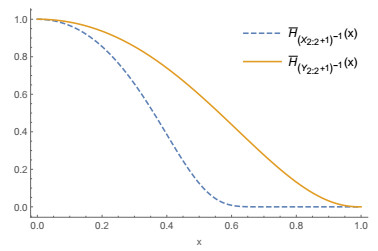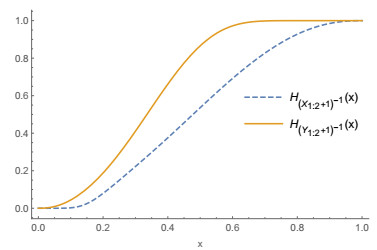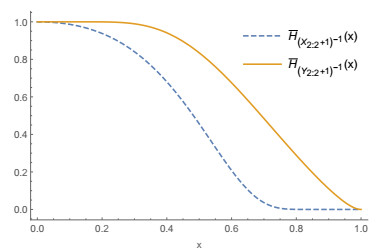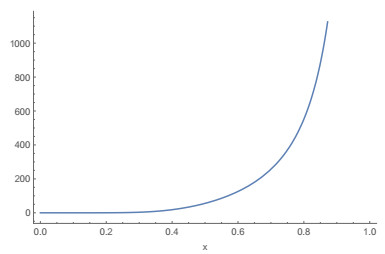1.
Introduction and preliminary definitions
In his survey-cum-expository review article, Srivastava [1] presented and motivated about brief expository overview of the classical q -analysis versus the so-called (p,q)-analysis with an obviously redundant additional parameter p. We also briefly consider several other families of such extensively and widely-investigated linear convolution operators as (for example) the Dziok-Srivastava, Srivastava-Wright and Srivastava-Attiya linear convolution operators, together with their extended and generalized versions. The theory of (p,q)-analysis has important role in many areas of mathematics and physics. Our usages here of the q-calculus and the fractional q-calculus in geometric function theory of complex analysis are believed to encourage and motivate significant further developments on these and other related topics (see Srivastava and Karlsson [2,pp. 350-351], Srivastava [3,4]). Our main objective in this survey-cum-expository article is based chiefly upon the fact that the recent and future usages of the classical q-calculus and the fractional q-calculus in geometric function theory of complex analysis have the potential to encourage and motivate significant further researches on many of these and other related subjects. Jackson [5,6] was the first that gave some application of q -calculus and introduced the q-analogue of derivative and integral operator (see also [7,8]), we apply the concept of q -convolution in order to introduce and study the general Taylor-Maclaurin coefficient estimates for functions belonging to a new class of normalized analytic in the open unit disk, which we have defined here.
Let A denote the class of analytic functions of the form
and let S⊂A consisting on functions that are univalent in Δ. If the function h∈A is given by
The Hadamard product (or convolution) of f and h, given by (1.1) and (1.2), respectively, is defined by
If f and F are analytic functions in Δ, we say that f is subordinate to F, written as f(z)≺F(z), if there exists a Schwarz function s, which is analytic in Δ, with s(0)=0, and |s(z)|<1 for all z∈Δ, such that f(z)=F(s(z)), z∈Δ. Furthermore, if the function F is univalent in Δ, then we have the following equivalence ([9,10])
The Koebe one-quarter theorem (see [11]) prove that the image of Δ under every univalent function f∈S contains the disk of radius 14. Therefore, every function f∈S has an inverse f−1 that satisfies
where
A function f∈A is said to be bi-univalent in Δ if both f and f−1 are univalent in Δ. Let Σ represent the class of bi-univalent functions in Δ given by (1.1). The class of analytic bi-univalent functions was first familiarised by Lewin [12], where it was shown that |a2|<1.51. Brannan and Clunie [13] enhanced Lewin's result to |a2|<√2 and later Netanyahu [14] proved that |a2|<43.
Note that the functions
with their corresponding inverses
are elements of Σ (see [15,16]). For a brief history and exciting examples in the class Σ (see [17]). Brannan and Taha [18] (see also [16]) presented certain subclasses of the bi-univalent functions class Σ similar to the familiar subclasses S∗(α) and K(α) of starlike and convex functions of order α (0≤α<1), respectively (see [17,19,20]). Ensuing Brannan and Taha [18], a function f∈A is said to be in the class S∗Σ(α) of bi-starlike functions of order α (0<α≤1), if each of the following conditions are satisfied:
and
where the function g is the analytic extension of f−1 to Δ, given by
A function f∈A is said to be in the class KΣ(α) of bi-convex functions of order α (0<α≤1), if each of the following conditions are satisfied:
and
The classes S∗Σ(α) and KΣ(α) of bi-starlike functions of order α and bi-convex functions of order α (0<α≤1), corresponding to the function classes S∗(α) and K(α), were also introduced analogously. For each of the function classes S∗Σ(α) and KΣ(α), they found non-sharp estimates on the first two Taylor-Maclaurin coefficients |a2| and |a3| ([16,18]).
1.1. Faber polynomial expansion of functions f∈A
The Faber polynomials introduced by Faber [21] play an important role in various areas of mathematical sciences, especially in Geometric Function Theory of Complex Analysis (see, for details, [22]). In 2013, Hamidi and Jahangiri [23,24,25] took a new approach to show that the initial coefficients of classes of bi- starlike functions e as well as provide an estimate for the general coefficients of such functions subject to a given gap series condition.Recently, their idea of application of Faber polynomials triggered a number of related publications by several authors (see, for example, [26,27,28] and also references cited threin) investigated some interesting and useful properties for analytic functions. Using the Faber polynomial expansion of functions f∈A has the form (1.1), the coefficients of its inverse map may be expressed as
where
such that Ui with 7≤i≤m is a homogeneous polynomial in the variables a2,a3,...,am, In particular, the first three terms of K−mm−1 are
In general, an expansion of K−nm (n∈N) is (see [29,30,31,32,33])
where Dnm=Dnm(a2,a3,...) and
while a1=1 and the sum is taken over all non-negative integers i1...im satisfying
Evidently
1.2. Quantum calculus operator
Srivastava [1] made use of several operators of q-calculus and fractional q-calculus and recollecting the definition and representations. The q-shifted factorial is defined for κ,q∈C and n∈N0=N∪{0} as follows
By using the q-Gamma function Γq(z), we get
where (see [34])
Also, we note that
and, the q-Gamma function Γq(z) is known
where [m]q symbolizes the basic q-number defined as follows
Using the definition formula (1.7) we have the next two products:
(i) For any non-negative integer m, the q-shifted factorial is given by
(ii) For any positive number r, the q-generalized Pochhammer symbol is defined by
It is known in terms of the classical (Euler's) Gamma function Γ(z), that
Also, we observe that
where (κ)m is the familiar Pochhammer symbol defined by
For 0<q<1, the q-derivative operator (or, equivalently, the q- difference operator) El-Deeb et al. [35] defined Dq for f∗h given by (1.3) is defined by (see [5,6])
where, as in the definition (1.7)
For κ>−1 and 0<q<1, El-Deeb et al. [35] (see also) defined the linear operator Hκ,qh:A→A by
where the function Mq,κ+1 is given by
A simple computation shows that
From the definition relation (1.9), we can easily verify that the next relations hold for all f∈A:
Remark 1. Taking precise cases for the coefficients bm we attain the next special cases for the operator Hκ,qh:
(ⅰ) For bm=1, we obtain the operator Iκq defined by Srivastava [32] and Arif et al. [36] as follows
(ⅱ) For bm=(−1)m−1Γ(υ+1)4m−1(m−1)!Γ(m+υ), υ>0, we obtain the operator Nκυ,q defined by El-Deeb and Bulboacă [37] and El-Deeb [38] as follows
where
(ⅲ) For bm=(n+1n+m)α, α>0, n≥0, we obtain the operator Mκ,αn,q defined by El-Deeb and Bulboacă [39] and Srivastava and El-Deeb [40] as follows
(ⅳ) For bm=ρm−1(m−1)!e−ρ, ρ>0, we obtain the q-analogue of Poisson operator defined by El-Deeb et al. [35] (see [41]) as follows
(ⅴ) For bm=[1+ℓ+μ(m−1)1+ℓ]n, n∈Z, ℓ≥0, μ≥0, we obtain the q-analogue of Prajapat operator defined by El-Deeb et al. [35] (see also [42]) as follows
(ⅵ) For bm=(n+m−2m−1)θm−1(1−θ)n n∈N, 0≤θ≤1, we obtain the q-analogue of the Pascal distribution operator defined by Srivastava and El-Deeb [28] (see also [35,43,44]) as follows
The purpose of the paper is to present a new subclass of functions Lq,κΣ(η;h;Φ) of the class Σ, that generalize the previous defined classes. This subclass is defined with the aid of a general Hκ,qh linear operator defined by convolution products composed with the aid of q-derivative operator. This new class extend and generalize many preceding operators as it was presented in Remark 1, and the main goal of the paper is find estimates on the coefficients |a2|, |a3|, and for the Fekete-Szegö functional for functions in these new subclasses. These classes will be introduced by using the subordination and the results are obtained by employing the techniques used earlier by Srivastava et al. [16]. This last work represents one of the most important study of the bi-univalent functions, and inspired many investigations in this area including the present paper, while many other recent papers deals with problems initiated in this work, like [33,44,45,46,47,48], and many others. Inspired by the work of Silverman and Silvia [49] (also see[50]) and recent study by Srivastava et al [51], in this article, we define the following new subclass of bi-univalent functions Mq,κΣ(ϖ,ϑ,h) as follows:
Definition 1. Let ϖ∈(−π,π] and let the function f∈Σ be of the form (1.1) and h is given by (1.2), the function f is said to be in the class Mq,κΣ(ϖ,ϑ,h) if the following conditions are satisfied:
and
with κ>−1, 0<q<1, 0≤ϑ<1 and z,w∈Δ, where the function g is the analytic extension of f−1 to Δ, and is given by (1.4).
Definition 2. Let ϖ=0 and let the function f∈Σ be of the form (1.1) and h is given by (1.2), the function f is said to be in the class Mq,κΣ(ϑ,h) if the following conditions are satisfied:
and
with κ>−1, 0<q<1, 0≤ϑ<1 and z,w∈Δ, where the function g is the analytic extension of f−1 to Δ, and is given by (1.4).
Definition 3. Let ϖ=π and let the function f∈Σ be of the form (1.1) and h is given by (1.2), the function f is said to be in the class HMq,κΣ(ϑ,h) if the following conditions are satisfied:
with κ>−1, 0<q<1, 0≤ϑ<1 and z,w∈Δ, where the function g is the analytic extension of f−1 to Δ, and is given by (1.4).
Remark 2. (ⅰ) Putting q→1− we obtain that limq→1−Mq,κΣ(ϖ,ϑ;h)=:GκΣ(ϖ,ϑ;h), where GκΣ(ϖ,ϑ;h) represents the functions f∈Σ that satisfy (1.18) and (1.19) for Hκ,qh replaced with Iκh (1.10).
(ⅱ) Fixing bm=(−1)m−1Γ(υ+1)4m−1(m−1)!Γ(m+υ), υ>0, we obtain the class Bq,κΣ(ϖ,ϑ,υ), that represents the functions f∈Σ that satisfy (1.18) and (1.19) for Hκ,qh replaced with Nκυ,q (1.12).
(ⅲ) Taking bm=(n+1n+m)α, α>0, n≥0, we obtain the class Lq,κΣ(ϖ,ϑ,n,α), that represents the functions f∈Σ that satisfy (1.18) and (1.19) for Hκ,qh replaced with Mκ,αn,q (1.14).
(ⅳ) Fixing bm=ρm−1(m−1)!e−ρ, ρ>0, we obtain the class Mq,κΣ(ϖ,ϑ,ρ), that represents the functions f∈Σ that satisfy (1.18) and (1.19) for Hκ,qh replaced with Iκ,ρq (1.15).
(ⅴ) Choosing bm=[1+ℓ+μ(m−1)1+ℓ]n, n∈Z, ℓ≥0, μ≥0, we obtain the class Mq,κΣ(ϖ,ϑ,n,ℓ,μ), that represents the functions f∈Σ that satisfy (1.18) and (1.19) for Hκ,qh replaced with Jκ,nq,ℓ,μ (1.16).
2.
Coefficient bounds for f∈Mq,κΣ(ϖ,ϑ;h)
Throughout this paper, we assume that
Recall the following Lemma which will be needed to prove our results.
Lemma 1. (Caratheodory Lemma [11]) If ϕ∈P and ϕ(z)=1+∑∞n=1cnzn then |cn|≤2 for each n, this inequality is sharp for all n where P is the family of all functions ϕ analytic and having positive real part in Δ with ϕ(0)=1.
We firstly introduce a bound for the general coefficients of functions belong to the class Mq,κΣ(ϖ,ϑ;h).
Theorem 2. Let the function f given by (1.1) belongs to the class Mq,κΣ(ϖ,ϑ;h). If ak=0 for 2≤k≤m−1, then
Proof. If f∈Mq,κΣ(ϖ,ϑ;h), from (1.18), (1.19), we have
and
Since
we know that there are two positive real part functions:
and
where
so that
and
Using (2.1) and comparing the corresponding coefficients in (2.3), we obtain
and similarly, by using (2.2) in the equality (2.4), we have
under the assumption ak=0 for 0≤k≤m−1, we obtain Am=−am and so
and
Taking the absolute values of (2.7) and (2.8), we conclude that
Applying the Caratheodory Lemma 1, we obtain
which completes the proof of Theorem.
Theorem 3. Let the function f given by (1.1) belongs to the class Mq,κΣ(ϖ,ϑ;h), then
and
Proof. Fixing m=2 and m=3 in (2.5), (2.6), we have
and
From (2.12) and (2.14), by using the Caratheodory Lemma1, we obtain
Also, from (2.13) and (2.15), we have
and by using the Caratheodory Lemma 1, we obtain
From (2.16) and (2.18), we obtain the desired estimate on the coefficient as asserted in (2.9).
To find the bound on the coefficient |a3|, we subtract (2.15) from (2.13). we get
or
substituting the value of a22 from (2.12) into (2.19), we obtain
Using the Caratheodory Lemma 1, we find that
and from (2.13), we have
Appling the Caratheodory Lemma 1, we obtain
Combining (2.20) and (2.21), we have the desired estimate on the coefficient |a3| as asserted in (2.10).
Finally, from (2.15), we deduce that
Thus the proof of Theorem 3 was completed.
3.
Fekete-Szegö inequality for f∈Mq,κΣ(ϖ,ϑ;h)
Fekete and Szegö [52] introduced the generalized functional |a3−ℵa22|, where ℵ is some real number. Due to Zaprawa [53], (also see [54]) in the following theorem we determine the Fekete-Szegö functional for f∈Mq,κΣ(ϖ,ϑ;h).
Theorem 4. Let the function f given by (1.1) belongs to the class Mq,κΣ(ϖ,ϑ;h) and ℵ∈R. Then we have
Proof. From (2.17) and (2.19)we obtain
So we have
Then, by taking modulus of (3.1), we conclude that
Taking ℵ=1, we have the following result.
4.
Conclusions and observations
In the current paper, we mainly get upper bounds of the initial Taylors coefficients of bi-univalent functions related with q− calculus operator. By fixing bm as demonstrated in Remark 1, one can effortlessly deduce results correspondents to Theorems 2 and 3 associated with various operators listed in Remark 1. Further allowing q→1− as itemized in Remark 2 we can outspread the results for new subclasses stated in Remark 2. Moreover by fixing ϖ=0 and ϖ=π in Theorems 2 and 3, we can easily state the results for f∈Mq,κΣ(ϑ;h) and f∈HMq,κΣ(ϑ;h). Further by suitably fixing the parameters in Theorem 4, we can deduce Fekete-Szegö functional for these function classes. By using the subordination technique, we can extend the study by defining a new class
where Ψ(z) the function Ψ is an analytic univalent function such that ℜ(Ψ)>0inΔ with Ψ(0)=1,Ψ′(0)>0 and Ψ maps Δ onto a region starlike with respect to 1 and symmetric with respect to the real axis and is given by Ψ(z)=z+B1z+B2z2+B3z3+⋯,(B1>0). Also, motivating further researches on the subject-matter of this, we have chosen to draw the attention of the interested readers toward a considerably large number of related recent publications (see, for example, [1,2,4]). and developments in the area of mathematical analysis. In conclusion, we choose to reiterate an important observation, which was presented in the recently-published review-cum-expository review article by Srivastava ([1], p. 340), who pointed out the fact that the results for the above-mentioned or new q− analogues can easily (and possibly trivially) be translated into the corresponding results for the so-called (p;q)−analogues(with 0<|q|<p≤1)by applying some obvious parametric and argument variations with the additional parameter p being redundant.
Acknowledgments
The researcher(s) would like to thank the Deanship of Scientific Research, Qassim University for funding the publication of this project.The authors are grateful to the reviewers for their valuable remarks, comments, and advices that help us to improve the quality of the paper.
Conflict of interest
The authors declare that they have no competing interests.


















 DownLoad:
DownLoad: